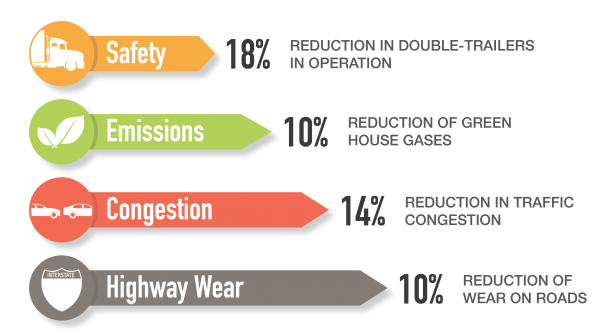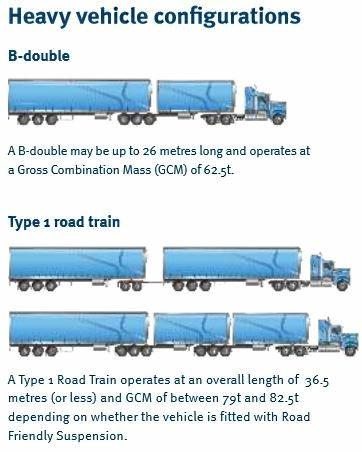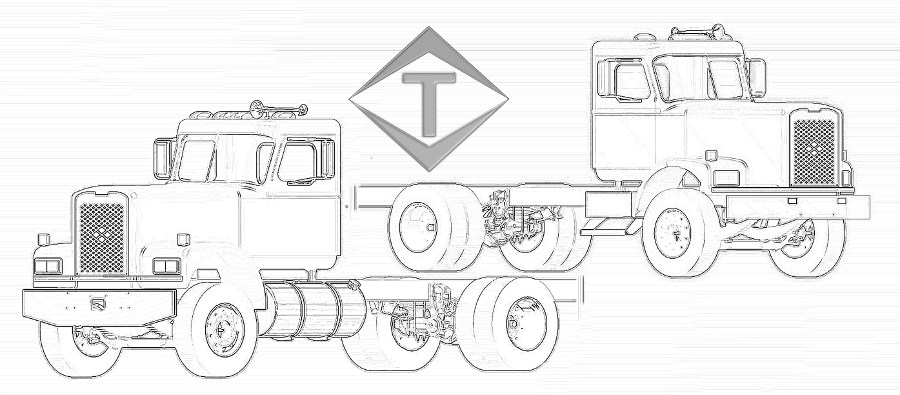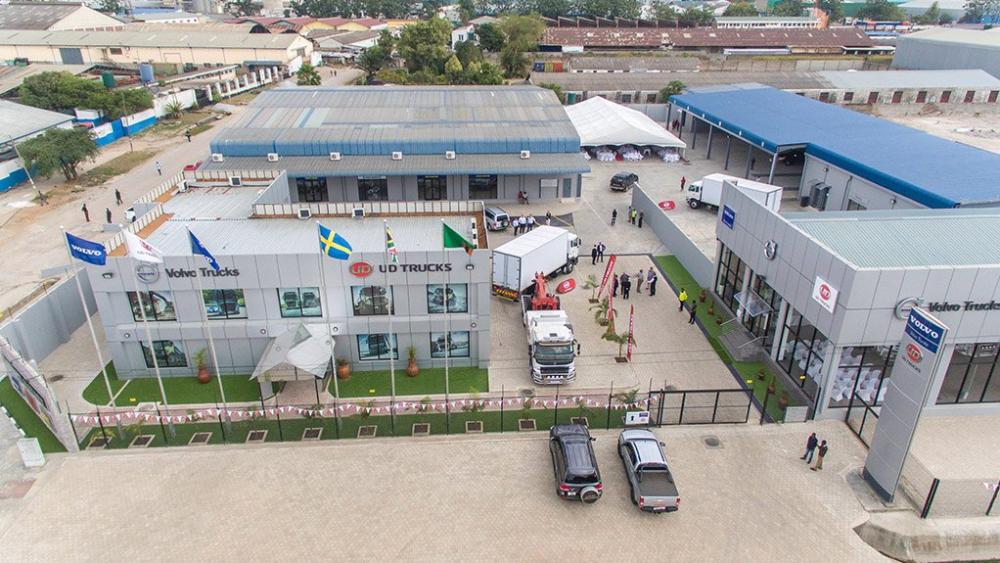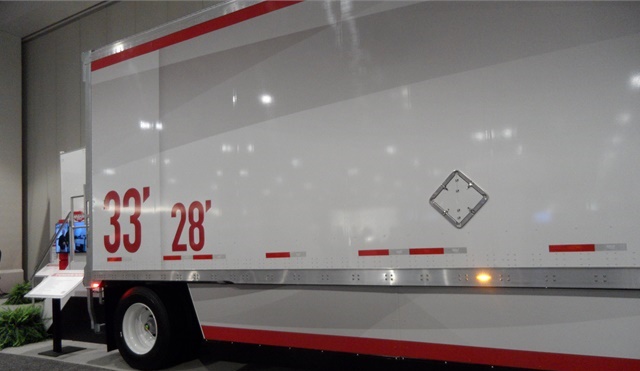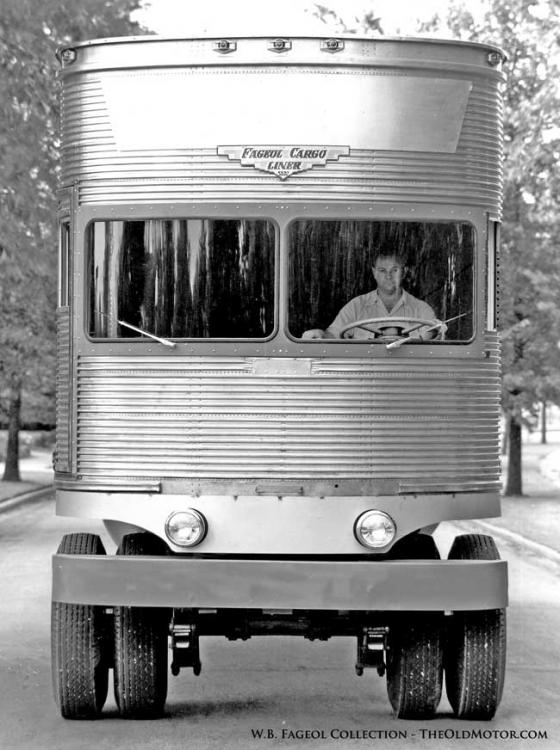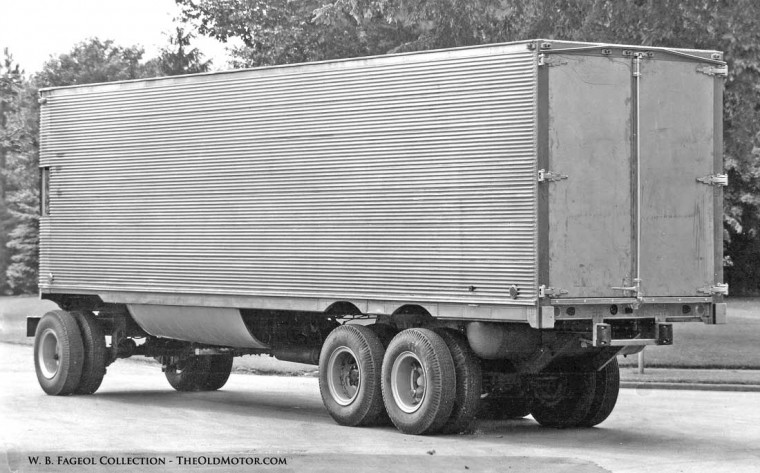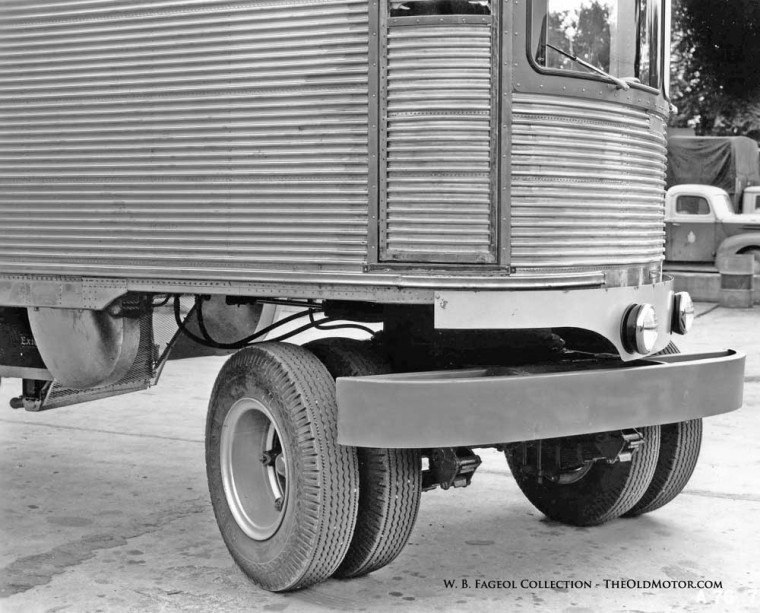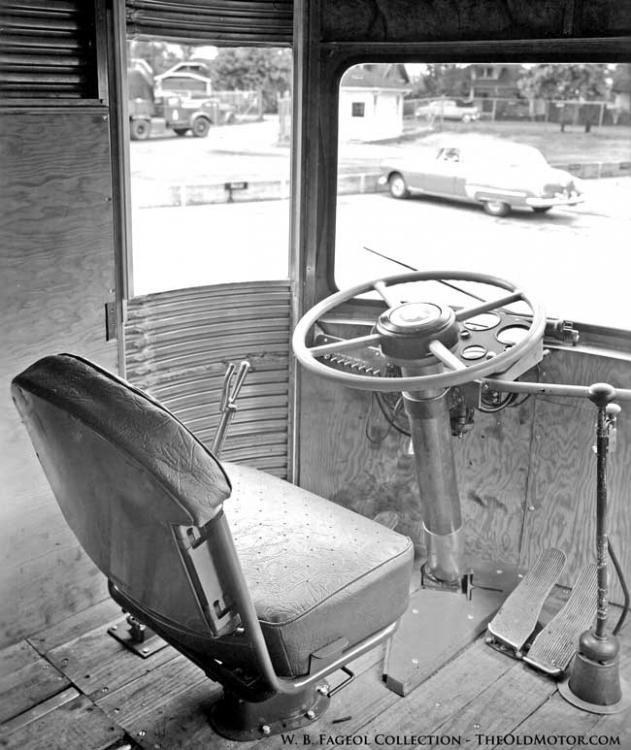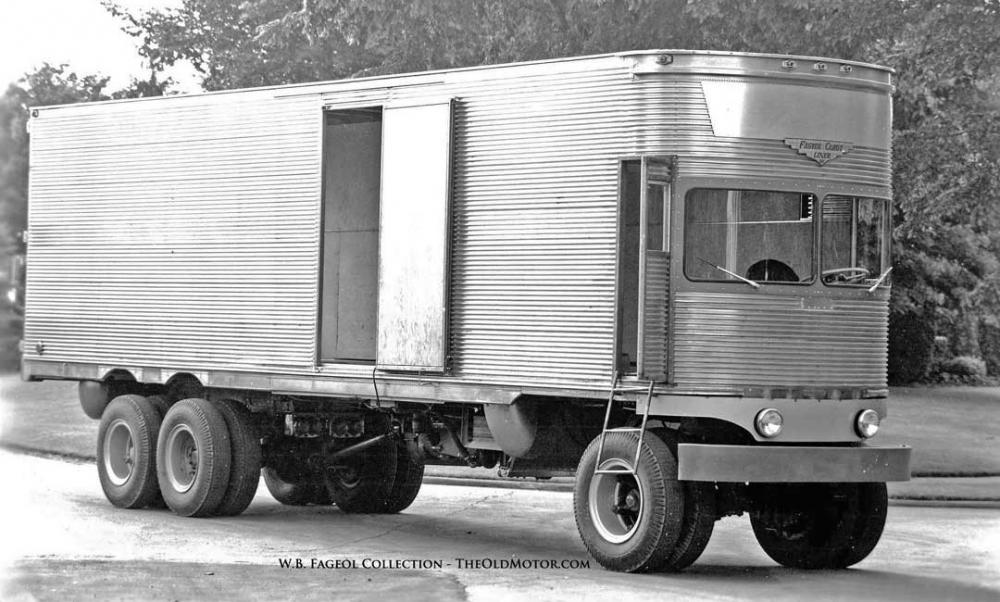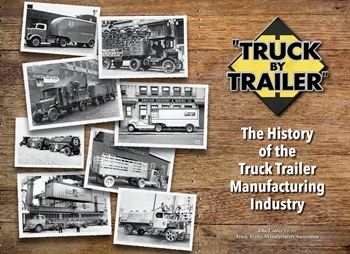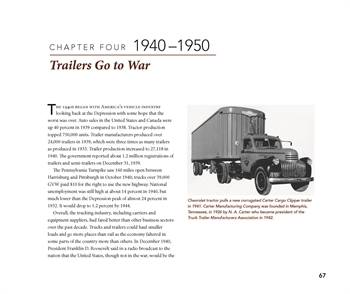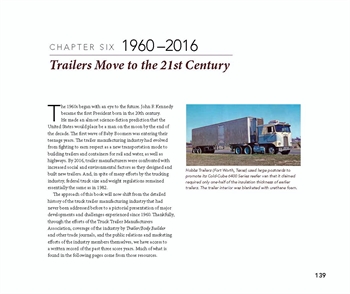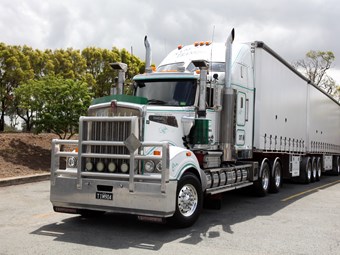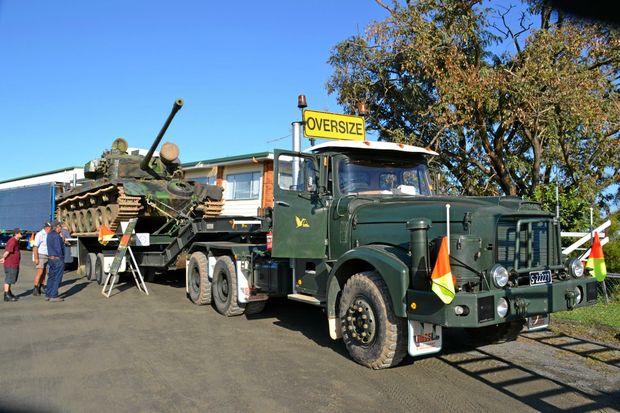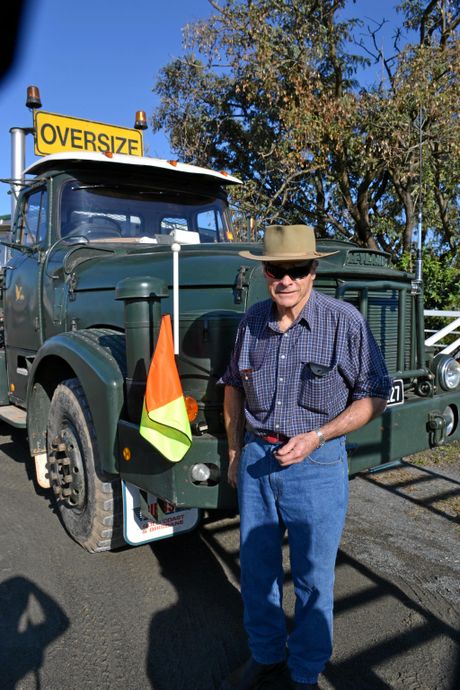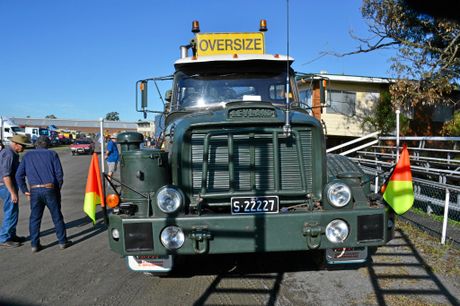
kscarbel2
Moderator-
Posts
18,873 -
Joined
-
Days Won
114
Content Type
Profiles
Forums
Gallery
Events
Blogs
BMT Wiki
Collections
Store
Everything posted by kscarbel2
-
Report touts savings from 33-foot twin trailers, downplays truckload's concerns Fleet Owner / June 21, 2017 Change would mean less congestion and emissions, FTR says. A new report from FTR Transportation Intelligence said allowing twin 33-foot trailers on the nation’s highways could lower costs as much as 10%, while having minimal disruption on the operations of the overall trucking industry. “The productivity gains from allowing 33 foot trailers will reduce the amount of work required in the trucking industry - resulting in fewer trucks on the highways, less damage to the pavement and reduced emissions,” said lead author Noel Perry, FTR partner and transportation economist. Perry previously held research positions at Schneider National, Cummins Engine Co. and CSX Corp. Perry said “the economic case for doubles limits the application to a very small part of the market,” and that the “drawbacks of increased handling and additional shipper dock access will prevent their use in the overwhelming majority of truckload freight.” Size-and-weight rules have long been a contentious issue within the trucking industry. Recent federal efforts to approve the use of twin 33-foot trailers have failed, but some analysts have suggested they could receive approval during the Trump administration. FTR said the additional length provides an 18% increase in cubic capacity over the current 28-foot trailers, and 24.5% gain over 53-foot dry van trailers. By putting more freight on trucks with the longer doubles, the result would be lower costs to carriers, shippers, and end consumers, especially those fueling “the exploding online market place.” Adoption costs would fall mainly on the less-than-truckload and parcel carriers interested in the change, and there would be little, if any, cost to the public, the report said. At the same time there would be a reduction in trucks on the road. FTR’s report breaks down several of the frequently cited reasons public safety groups and truckload carriers tend to oppose the change. Perry noted although individual tractor-trailers would produce additional emissions, he estimated a 10% reduction when factoring in the fewer number of rigs needed. Similarly, he projected drops in fuel use, highway wear, and congestion, as the larger trailers move the same amount of freight in 14% less highway space. Additionally, Perry suggested any potential per-truck safety risk “should be more than offset by the reduction in overall rigs.” FTR projects the total population of doubles could increase from 5% of all trucks today to as much as 8%. While that does represent a significant increase, a common refrain from safety advocates, the argument falls flat when factoring in the overall decline in total trucks on the road, the report said. Perry was also critical of truckload carriers fighting the change, suggesting their economic concerns are overblown. He estimated it would impact less than 2% of the truckload market. “Any pressures on truckload operations will be limited to small, specialized niches,” the report said. As with previous innovations, Perry said truckload executives would be able to efficiently manage these changes through rate alterations or operational adjustments. Earlier this year, the Truckload Carriers Association reiterated its opposition to efforts to gain approval for twin 33s. “While TCA strongly supports a thoughtful, evolutionary pace for the development and deployment of productivity innovations that benefit the entire trucking industry, the revolutionary change of allowing twin 33-foot trailers on federal-aid highways would have only benefited a small minority of the trucking industry, while the nature and pace of such a change would have been detrimental to the trucking industry in general, and to the truckload carrier segment specifically,” the group said. FTR’s report also listed several factors that could limit the use of the longer trailers, if they are approved. Facilities need to be located close enough to approved highways to allow direct pickup and delivery, and provide the needed the maneuvering space and extra docks to handle the longer doubles. Another limitation could be the ability to find backhauls to make them economically viable, the report noted. .
-
Bill aims to repeal 12% federal truck sales tax
kscarbel2 replied to kscarbel2's topic in Trucking News
New legislation aims to repeal federal excise tax on trucks Fleet Owner / June 21, 2017 Originally introduced in 1917 to help defray the costs of World War I, the FET now stands at 12%. U.S. Representative Doug LaMalfa (R-CA) introduced a bill this week that seeks to eliminate the 12% federal excise tax or “FET” most heavy-duty trucks, tractors and commercial trailers – a levy the American Truck Dealers (ATD) group claims can add anywhere from $12,000 to $22,000 to the sticker prices for such equipment. “The excessive 12% FET on heavy trucks adds tens of thousands of dollars to truck purchases and directly impacts the cost of food, consumer goods and other products Americans need,” Rep. LaMalfa noted in a statement. “Even worse, truck owners large and small pay this tax whether a truck is driven 100,000 miles or never driven at all, forcing them to pay taxes on an investment that may not be generating any revenue,” he stressed. “Repealing the truck tax will help small businesses invest in new equipment while jump-starting domestic manufacturing and Congress should address this issue as we consider how to reform our outdated tax code,” Rep. LaMalfa added. “The 12% FET on heavy-duty trucks in the highest percentage rate of any federal excise tax that Congress levies,” noted ATD’s Chairman Steve Parker in a statement. “The FET depresses new heavy-duty truck sales and delays the deployment of cleaner, safer and more fuel-efficient trucks.” Rep. LaMalfa’s bill – H.R. 2946 and dubbed the Heavy Truck, Tractor and Trailer Retail Federal Excise Tax Repeal Act of 2017 – follows a similar effort to eliminate the FET attempted five years ago. ATD noted that the FET was originally imposed in 1917 to help defray the cost of World War I. The tax has grown from 3%, when it was incorporated into the Highway Trust Fund in 1955, to its 12% level today. -
Jason Cannon, Commercial Carrier Journal (CCJ) / June 21, 2017 U.S. Rep. Doug LaMalfa (R-Calif.) introduced Tuesday a bill that seeks to repeal the federal excise tax (FET) on the retail sale of most heavy-duty trucks, tractors and trailers. Bills similar to H.R. 2946, “Heavy Truck, Tractor and Trailer Retail Federal Excise Tax Repeal Act of 2017,” have been introduced over the past several years, with none gaining enough traction to get the 12-percent tax removed from the sticker price of the truck. LaMalfa’s bill now heads to the House Ways and Means Committee. “The excessive 12-percent federal excise tax on heavy trucks adds tens of thousands of dollars to truck purchases and directly impacts the cost of food, consumer goods and other products Americans need,” LaMalfa says. “Even worse, truck owners large and small pay this tax whether a truck is driven 100,000 miles or never driven at all, forcing them to pay taxes on an investment that may not be generating any revenue. “The 12-percent federal excise tax on heavy-duty trucks in the highest percentage rate of any federal excise tax that Congress levies, and it adds $12,000 to $22,000 to the price of a new heavy-duty truck,” adds American Truck Dealers (ATD) Chairman Steve Parker, who is also the president of Baltimore Potomac Truck Centers. “The FET depresses new heavy-duty truck sales and delays the deployment of cleaner, safer and more fuel-efficient trucks.” Rep. LaMalfa’s bill has the support of ATD, which represents more than 1,800 U.S. commercial truck dealers. The group is hosting its annual legislative fly-in to Washington, D.C., this week to rally congressional support for the legislation. LaMalfa says repealing the truck tax will help small businesses invest in new equipment and jump-start domestic manufacturing, while also reforming an outdated tax code. The FET was originally imposed in 1917 to help defray the cost of World War I. The tax has grown from 3 percent, when it was incorporated into the Highway Trust Fund in 1955, to 12 percent today. Parker called on Congress to include H.R. 2946 in the upcoming tax reform bill.
-
https://www.bigmacktrucks.com/topic/30897-egr-delete-kit/#comment-179300 https://www.bigmacktrucks.com/topic/50007-2008-mp8-egr-question/ https://www.bigmacktrucks.com/topic/46210-egrdpf-delete/#comment-340376 https://www.bigmacktrucks.com/topic/42710-mp8-egr-dpf-delete-software/#comment-311883
-
Limited edition Diamond T glider kit offering unveiled
kscarbel2 replied to kscarbel2's topic in Trucking News
TC-116DB/DF Classic Truck Spec Sheet - https://tlinetrucks.com/wp-content/uploads/2016/07/ClassicTruckSpecSheet.pdf -
Big Rigs / June 20, 2017 It’s good news for Central and North Queensland beef producers and processors with the Department of transport announcing type 1 road trains will be allowed to travel through Rockhampton from July 1. Previously type-one road trains, which are made up of two 40-foot trailers, have had to downsize at the CQLX before heading into town and onto the Teys Lakes Creek or JBS Rocky Plant. By law they are required to drop one trailer before heading into town, meaning two single trips had to be made to the meatworks, or cross-load stock onto B-doubles, which is considered one of the most dangerous activities in the cattle transport industry. Not being able to travel through town in a type-one road train means added costs to processors and producers arriving from western selling centres. It also means an additional two hours per load in labour to move cattle from one vehicle to another. A report released by The Department of Transport reported with 500,000 cattle on average transported through Rockhampton and onto the meatworks in a year, the restriction on type-one road trains means thousands of cattle freight movements. The latest announcement does not affect cattle travelling north or south along the Bruce Hwy but it will improve animal welfare and product outcome on cattle drawn from central, west and northern Queensland. Not to mention the improvement in efficiency and the decrease in overall transport movements. The approval also reduces the need for cross-loading during trips to the meatworks, which involves operators positioning trailers together and with the use of sliding gates, push cattle from one trailer deck to another. Central Queensland Regional Manager for AgForce Sharon Howard says this means producers will enjoy lower producers will enjoy lower transport costs, safer livestock transport and better meat quality in their herd. "Drivers will see less trucks on the roads because we have the ability to transport more cattle per truck," she said. Ms Howard said it was good to see cross loading would no longer be needed. "Trucks will be able to travel from Western Queensland direct to the meat works without cross loading, saving freight costs," she said. .
-
Limited edition Diamond T glider kit offering unveiled
kscarbel2 replied to kscarbel2's topic in Trucking News
Complete Diamond T Trucks Launched TC-116DB/DF Classic Truck Spec Sheet - https://tlinetrucks.com/wp-content/uploads/2016/07/ClassicTruckSpecSheet.pdf TC-11620DB/DF Classic Glider Spec Sheet - https://tlinetrucks.com/wp-content/uploads/2017/06/ClassicGliderSpecSheet-1.pdf . -
Volvo Trucks, UD Trucks open R130m facility in Zambia
kscarbel2 replied to kscarbel2's topic in Trucking News
The talk of the Mack brand still having a presence in Africa have been greatly exaggerated. Apparently, Volvo only views Africa as a key market for the Volvo and UD brands. -
Engineering News / June 20, 2017 Volvo Group Southern Africa, in partnership with Titanium Motors, has opened a new dealer facility in the Zambian capital, Lusaka, in a R130-million investment. The dealership will provide services to Volvo Trucks and UD Trucks customers operating in the region. “Zambia is a key African market for Volvo Group. Apart from its very central location in Southern Africa, it also has exciting potential as a developing market with a growing economy and emerging infrastructure,” says Volvo Group Southern Africa president Torbjörn Christensson. “We are proud to partner with Titanium Motors in Zambia, and we are looking forward to effectively support our local customers, and to grow our overall market share in the region.” Christensson says transport, and especially trucks, are essential to the region’s growth, and to drive development and progress. For this reason, Volvo also has a representative office in Lusaka, to harness this potential and to provide support from head office. The 7 500 m² dealership consists of a showroom and a training facility. It also hosts six work bays, trained and accredited technicians, mobile service units, a parts warehouse, as well as dedicated sales teams for each of the brands. Volvo Trucks and UD Trucks are both owned by the Volvo group. .
-
FTR: The Economics of 33' Trailers Only Benefit a Few Markets Heavy Duty Trucking / June 20, 2017 FTR released a new report detailing the economics of using twin 33-foot trailers compared to twin 28-foot trailers and standard 53-foot trailers, showing that in only specific cases would the extra capacity lead to a benefit. The change from 28-foot to 33-foot double trailers has primarily been based on safety concerns, but newer technologies have allowed for the safe operation of larger trucks since the last expansion of length limits in the early 1990s, according to FTR. Regulators have been debating a proposal to increase the federal maximum length, which would lead to an overall increase of 10 feet for the entire rig. The thinking behind such an increase is that it would increase capacity per truck. But in reviewing the economics of the change, FTR found that adoption of double 33-foot trailers would likely be limited. It would benefit primarily less-than-truckload and parcel carriers and more niche operations such as the movement of caskets or insulation. Based on its own research, FTR expects load conversion in just the 1-2% range. While double trailers present increased capacity in space and weight over a single trailer, for shippers of low-density freight the gain in loading capacity is only 4%. The main reason that carriers choose twin trailers over a single trailer is what the industry calls "unit" loading, a common practice in LTL and parcel operations. Since the cube advantage over 53-foot trailers is relatively small, the main reason for a carriers’ preference for doubles is to avoid the re-sorting required to consolidate many customer shipments as the freight moves across the hub-and-spoke terminal networks. FTR found that for the segments most directly affected by increasing the allowable trailer length, they would see as much as a 10% increase in cost savings. It also expects the longer trailers to decrease the number of trucks on the road by 18% in the affected segments of trucking, which would lead to lower overall emissions. Trucking costs don’t increase in proportion to the length of a trailer, which means that 33-foot trailers would be cheaper to operate than 28-foot trailers on a per-ton basis, according to FTR. A drawback to using longer trailers in the increased handling and need for additional loading space, with FTR calling the change a niche play only. The limited scope of fleets that would be interested in longer double trailers is actually one of the advantages that FTR wants lawmakers to consider while pushing for the increased maximum length. This could downplay public fears about significant amounts of larger vehicles on the road because the change would not be as obvious. FTR also believes the because the change is simple and requires no new technology and no need for costly changes to infrastructure, longer trailers would also be an easy sell. Lastly, the tradeoffs for the fleets that would use them are obvious and significant. .
-
New book highlights trailer history, importance
kscarbel2 replied to kscarbel2's topic in Trucking News
The Fageol 1950 TC CargoLiner – A Trailer Without A Tractor The Old Motor / February 6, 2015 William B. Fageol and his brother Frank R. Fageol started the Fageol Motors Company during 1916 in Oakland, California. The first vehicle was the amazing 1917 130 h.p. Fageol Supercar that was an unfortunate causality of World War I. Later on the Company focused on the impressive Fageol Safety Coach and a line of Fageol trucks all of which you can learn about here on The Old Motor. Louis J. Fageol was Frank R. Fageol’s son who ended up running the Twin Coach Company after his brother Oren died in 1943. In addition to overseeing the business, Louis was a well-known speedboat racer who won the Gold Cup in 1951 with his hydroplane Slo-Mo-Shun V. He also built Indianapolis racing cars and bought the ex. Joe Thorne owed, Art Sparks built coupe and finished it up with one of his own motors and named it the Fageol Super Sonic. Sales of buses at Twin Coach and all the other bus builders other than GM dropped in the late forties. Needing a new product to build, the firm in October of 1950 introduced a new concept vehicle that it named the Fageol Super Freighter. The unique unit was a self-propelled trailer minus the tractor, with the drivers compartment located up front and the engine mounted in the middle of the unit under the floor. Exactly who designed this new truck is not known, but Louis J. Fageol filed the patent application for the renamed Fageol TC CargoLiner on November 30, 1950. It used an under-floor diesel engine (seen in the last photo below) that drove through a rear drive axle, and were both apparently built by International Harvester. This demonstrator was built in 1950 as part of the effort to land an Army contract for 1,650 vehicles. The prototype stainless body was constructed by the Fruehauf Trailer Corporation, and the front of it was mounted on a steerable bogey axle that was hydraulically controlled. This front axle assembly can be seen in the third photo below. It appears the effort only resulted in one Cargoliner being built, but Twin Coach went on to build over 1500 F-32-F Convertible Buses for the Army. Later on it was followed up in 1952 by the production of the Twin Coach Fageoliner, a civilian bus. You can learn all about the Fageol Twin Coach Bus here. The photos are courtesy of the W.B. Fageol Collection. . -
New book highlights trailer history, importance
kscarbel2 replied to kscarbel2's topic in Trucking News
The Fageol Cruise Liner was an idea that “came and went” in 1950. The “trailer” was produced by the Twin Coach Company (Kent, Ohio). This vehicle appeared in an advertisement that claimed it to be up to 8,000 lbs. lighter and 10 ft. shorter than a conventional tractor and semi-trailer. International Nickel Company supplied the 18-8 austenitic chromium stainless steel used in the body. A diesel engine was mounted under the “cab.” (From the book, Truck by Trailer: The History of the Truck Trailer Manufacturing Industry) . -
Trailer-Body Builders / June 20, 2017 If you’re a Trailer-Body Builders reader, then the chances are good you’ll be interested in a new book by a long-time veteran of the business. Truck by Trailer: The History of the Truck Trailer Manufacturing Industry is being billed as the first book to recognize the truck trailer as a unique transportation vehicle. Written by John L. Conley—who spent 40 years with the trucking industry, including as editor of Modern Bulk Transporter magazine and with the trade association National Tank Truck Carriers Inc.—the book highlights the importance of the truck trailer as part of the celebration of the 75th Anniversary of the Truck Trailer Manufacturer’s Association. After all, as the book details, the introduction of the truck trailer in the early 1900s revolutionized materials distribution much as had the first steamboats, railroad cars, airplanes, trucks, and intermodal shipping containers. And some of the same type of operational and regulatory challenges that faced trailer builders a century ago remain today. But trailers proved their value during two world wars and those wartime experiences led to engineering and manufacturing advancements that long benefited commercial users. While methods and materials of trailer construction to serve expanding markets have changed over the years, the principle of providing the economy with a versatile and dependable tool for moving materials has remained unchanged. Catch up on the complete history of the truck trailer industry by ordering Conley's book from the TTMA Online Store. .
-
"If you want to build cars in the world, then I wish you all the best. You can build cars for the United States, but for every car that comes to the USA, you will pay 35 percent tax." Donald Trump / January 17, 2017 ----------------------------------------------------------------------- “We want to have new plants built in Michigan, and new plants built in Ohio, and new plants in Pennsylvania and North Carolina and so many other locations.” “We’re going to make thousands and thousands and thousands of additional cars. And we’re going to make them in the United States.” “We want to be the car capital of the world again. We will be, and it won’t be long, believe me.” President Donald Trump / March 15, 2017
-
Ford to Save $1 Billion Building Focus in China Instead of Mexico Bloomberg / June 20, 2017 Ford Motor Co. is canceling controversial plans to build the Focus small car in Mexico, saving $1 billion by ending North American production entirely and importing the model mostly from China after next year. The U.S. automaker will start making the next-generation Focus in China from the second half of 2019, a year after output ends at one of its plants in Michigan. Ford’s savings will come from canceling plans to assemble the car at an existing factory in Mexico and a decision made in January to abort construction of a plant in Mexico. With its latest move, Ford has fully abandoned its strategy of relocating small car production to Mexico that had been announced last year by then-Chief Executive Officer Mark Fields. Fields was replaced as CEO last month by Jim Hackett, former CEO of office-furniture maker Steelcase Inc. The company will be testing both consumer appetite for China-built cars and the tolerance of President Donald Trump, who has criticized automakers for importing vehicles from overseas. “We’ve done a lot of research and consumers care a lot more about the quality and the value than they do about the sourcing location,” Joe Hinrichs, Ford’s president of global operations, said in a conference call with reporters Tuesday. “iPhones are produced in China, for example, and people don’t really talk about it.” Ford said it’s also investing $900 million at its truck factory in Kentucky to build Expedition and Lincoln Navigator sport utility vehicles, preserving 1,000 jobs. After importing initial production of the new Focus cars from China, Ford will ship variants of the model later from Europe, the company said. The Michigan Assembly Plant now making the Focus will be retooled to produce the Ranger midsize pickup in late 2018 and the Bronco midsize SUV in 2020. “China gets a lot of attention, we’ll see how this plays out,” Hinrichs said in response to a question about possible criticism of the move from Trump. “But we believe this is a much better plan for our business globally. And it frees up from the original plan about $1 billion of capital that we can reinvest in the business, including exciting things that we’re working on in autonomy and electrification and a lot of that work is done right here in the U.S.” Video - https://www.bloomberg.com/news/videos/2017-06-20/ford-s-china-move-for-focus-opens-u-s-to-suvs-video -------------------------------------------------------------------------- Ford to import U.S. Focus from China instead of Mexico Automotive News / June 20, 2017 Ford Motor Co. plans to import its next-generation Focus sedan from China, abandoning plans to build the small car in Mexico. Production will begin in the second half of 2019, Ford said Tuesday. Most of the initial models for North America will come from China, with additional variants coming from Europe. Ford already builds the Focus for the Chinese market at its Changan Ford Assembly Plant 1 and 2 in Chongqing, China. Ford currently makes the Focus at its Michigan Assembly Plant in Wayne, Mich., but production is scheduled to end there in 2018 as the automaker makes room for the Bronco SUV and Ranger midsize pickup. Ford originally planned to move Focus production to a new, $1.6 billion plant in San Luis Potosi, Mexico, but the company canceled those plans in January, less than a year after announcing them. Ford then planned to build the cars at its existing plant in Hermosillo. Ford said at the time the move would save $500 million, and it now says building the car in China will save an additional $500 million, for a total savings of $1 billion in production costs. “We’ve done a lot of research and consumers care a lot more about the quality and the value than they do about the sourcing location,” Joe Hinrichs, Ford’s president of global operations, said in a conference call with some reporters Tuesday. “iPhones are produced in China, for example, and people don’t really talk about it.” Others importing General Motors last year became the first U.S. automaker to import a vehicle from China with the launch of the Buick Envision. It also makes the Cadillac CT6 plug-in hybrid there. Volvo, which is owned by China's Geely Automobile Holdings, also builds some cars in China for the U.S. market. Although it is cheaper to build and ship cars to the U.S. from Mexico than China, "this was not a variable cost decision," Hinrichs said. "It allows us to free up a lot of capital" because Ford now has to retool only one plant -- the Chongqing plant -- rather than two to supply North America. Given dwindling overall U.S. demand for small cars such as the Focus, "we thought this was the best balance of that cost/capital tradeoff," Hinrichs said. Focus sales have fallen 19.7 percent in the U.S. through the first five months of the year to 67,146, according to the Automotive News Data Center. Hinrichs said Ford planned to inform the White House this morning. There was no immediate comment from the White House. Asked if Ford was concerned about having to pay a border tax, as President Donald Trump has threatened on vehicle imports from Mexico, Hinrichs said "the capital saving outweighs the risk" of a potential tax on the Chinese-built Focus. Kentucky plans Ford also said Tuesday it will invest $900 million at its Kentucky Truck Plant for production of the new Expedition and Lincoln Navigator SUVs. The move will preserve 1,000 jobs at the plant, Ford said. The investment goes beyond Ford’s pledge to invest $600 million there through 2019 as part of its 2015 contract with the UAW. Ford in late 2015 invested $1.3 billion for production of its aluminum-bodied Super Duty, although that money was tied to its 2011 UAW deal. “Large SUVs are attracting a new generation around the world -- and we’re finding new ways to deliver the capability, versatility and technology that customers around the world really want with our all-new Ford Expedition and Lincoln Navigator,” Hinrichs said. “At the same time, we also have looked at how we can be more successful in the small car segment and deliver even more choices for customers in a way that makes business sense.”
-
If the shareholders of Volvo Group have the Mack brand in their long term plans (?), I would dispense with the present Mack brand leadership and attempt a dynamic new business model (Volvo has nothing to lose). Calling a spade a spade, the state of Mack brand management has been bleak for years, resulting in the entire distributor body being disgusted and disillusioned. Mack has never been run right since Volvo took over. A handful of Mack veterans tried to hang in there, like Kevin Flaherty and Paul Vikner, but their hands were always tied. Denny Slagle* has been the president of Mack since 2008. For nine years, he has failed to return the Mack brand to greatness. The portfolio has never been smaller and sales are stagnant. The Mack brand ranks 6th because it is no longer competitive. Frequent job changer Jonathan Randall is a waste of time. An unqualified Stephen Roy, appointed President of North American Sales & Marketing in 2014, was quickly demoted to watching over Volvo's "uptime" unit. Paraphrasing what Zenon C.R. Hansen said in 1965, Volvo needs to dispense with its unqualified Mack brand management and get others who know something about trucks. ------------------------------------------------ Faced with a total lack of experienced leadership at Mack brand corporate, I suggest Martin Lundstedt reach out to the real North American Mack experts who actually know what's going on. I propose he orchestrate an agreement under which the “Mack Distributor Council” would run the Mack brand. The Mack Distributor Council is composed of the nation’s most savvy Mack distributor principals, people with decades of knowledge and experience. Volvo will never understand the Mack brand and its customer base in the intimate way that they do. Only the members of the Mack Distributor Council know how to unleash the value of the Mack brand. The Mack Distributor Council includes those listed below and many other distinguished individuals: Jim Bland Transource Brian and Chris Bruckner Bruckner Truck Sales Russ Ellett Virginia Truck Center Terry Dotson and Scott Blevins Worldwide Equipment Jim and Rod Maddox Tri-state Truck Center Jon Pritchett NexTran John and Matt Niebauer W.W. Engine and Supply Steve and Scott Parker Baltimore-Potomac Truck Group Nobody is going to make better decisions than the people whose livelihoods depend on the continued success of the Mack brand. The members of the Mack Distributor Council will forget more about Mack than the present individuals in Greensboro will ever know. ------------------------------------------------ * Background - Dennis R. Slagle 1976 – Graduated from West Virginia Wesleyan College with a Bachelor of Science degree ? - Joined Price Waterhouse. 1980 - 1989 Joined the US arm of construction and agriculture machinery maker JCB as chief financial officer 1989 - 1991 Became JCB’s U.S. market vice-president of sales 1991 - 2000 Became president of JCB Inc. (JCB’s U.S. market business unit) 2000 - 2002 Senior vice-president of sales, Volvo Construction Equipment (VCE). 2002 - 2003 President, L.B. Smith 2003 - 2008 President and CEO, Volvo Construction Equipment (VCE). 2008 - 2011 President and CEO, Mack Trucks (succeeding Paul Vikner) 2009 - 2011 President and CEO, North American Trucks unit of Volvo AB 2012 – ? Volvo Group executive vice president for Trucks Sales & Marketing Americas* * Relating to Volvo’s truck business restructuring (http://www.volvogroup.com/group/global/en-gb/newsmedia/pressreleases/_layouts/CWP.Internet.VolvoCom/NewsItem.aspx?News.ItemId=109874) ? - 2/29/2016 President, Volvo Group Trucks Sales North America (removed from the executive board) 3/1/2016 – Present President, Mack Trucks (restored to the new exec board. Demoted to president of Mack, stripped of the Volvo brand, now only responsibility for Mack brand. Former President Stephen Roy demoted to North American Mack sales manager)
-
.
-
So based on what we know, General John R. Allen authorized Army personnel to carry firearms in Afghanistan, and always with a loaded magazine. Or at least, that's my perception.
-
I think the V8 would be right at home in North America. https://www.bigmacktrucks.com/topic/39056-driving-a-scania-is-‘better-than-sex’-truck-enthusiast-claims/#comment-280515
-
Owner-Driver / June 16, 2017 Graeme ‘JD’ Locke knows what he likes and that’s his current steed – a 2007 Kenworth T904. What he’s not keen on is the current state of the transport industry. Peter and Di Schlenk write Graeme Locke, better known as ‘JD’, doesn’t get home too often. He says his official place of residence is Kingaroy, Queensland, because "that’s where my stuff is", but he spends most of his time in a Kenworth T904, driving for Tim North Transport from its base in the Brisbane suburb of Gracemere. JD, whose nickname was arrived at through his and his father Barry’s middle initials, has been in the T904 since September 2016, driving up and down the east coast. It’s a 2007 model with a C15 Cat, 18 speed gearbox and Kenworth air bag rear suspension. JD says it has all the trimmings, making it very liveable. "It’s got an Icepack, cupboards, fridge and TV. I wouldn’t drive anything but a 909," he says. JD has driven all makes and models, including Kenworths from the T401 up to the 909, as well as Volvos, DAFs and Scanias. "But I wouldn’t have anything else but a long wheel base 909. You just can’t beat it." JD was doing containers and general in Sydney before deciding to move north. He’s driven for large companies but is happy to be driving for a company with a fleet of three. "It’s a good truck and Tim’s a good boss," he says. "He’s very meticulous about maintenance, an old fashioned sort of bloke. "He’s more anal about maintenance than I am with cleaning. "It gives you peace of mind because nothing is an issue." Disjointed industry Although JD is happy with the company and the truck, he has more than a thing or two to see about the trucking industry. "I think the industry needs a good kick up the arse," he exclaims. "We are a massive industry with no-one leading it. It’s so disjointed. "We could control the country even if it’s just to get better roads and rates. Unfortunately, nobody has any backbone. "You can’t say things because it might upset someone." JD would like to see a stronger well run union that should have a slush fund from all the membership fees. The funds would be pooled and for example, September 1, every truck will have the keys out for two weeks. "That would wake the country up," he says. "You amalgamate this whole industry as one and you would have something more powerful than anything else in this country." The fact that trucks are limited to 100km/h is another point of annoyance for JD. He believes trucks should be doing 110km/h because "we are the professionals out on the roads every day". "We are up and down the same stretches of bitumen and yet we are harassed. We are fined for spelling mistakes and being five minutes over. "I think it is a disgrace the way we are treated. We are not school kids; we’re driving millions of dollars’ worth of gear on the road as compared to a $20,000 car. "We do 15 times more kilometres a year than a car driver, yet we’re the ones being chased and that’s a disgrace. We should be respected. "I believe that with driver fatigue and driver management, they have got it all wrong," JD continues. "If you are prepared to be disciplined on your diet, your sleep, on your travel times, on your driving, you should have some label on your truck." JD has spent his entire working life driving trucks. He believes that either you love it or you don’t. If you don’t, you need to get out. "There are a lot of blokes coming into the industry, and they need to be taught," he continues. "Just because you can put a key in and drive it out of the driveway, doesn’t constitute that you know how to drive a truck. "But nobody tries to educate them. All they do is abuse them so then they think they are being outcast. "I think a lot of the onus should be on the big companies. I know they need drivers and that they have a business to survive, but unfortunately the industry is decaying." Outback bitumen JD has travelled on most Australia highways and he says the T904 smooths out many of the rough patches, although he believes the roads in general have improved, especially the Pacific Highway. Not so in the outback however where he previously drove roadtrains, carting grain. "You may as well get a can of black paint and paint the road," he says. "What they are doing is just spraying a layer of asphalt over any problems, putting new lines on it and that’s it. "It actually makes the bumps higher and lower so the ride is rougher." JD says making the eastern seaboard highways dual lane, but he says the governments should concentrate on where the road trains and cattle trucks go. "Where does all our fuel tax go?" he queries. "The country needs to step up in the inland roads. Not so much the goat tracks going to farms but the major arterial routes." JD knows his stuff. He’s been behind the wheel of a rig of some description for his entire working life. He’s also tried his hand at transport management. "If you’re in management and people don’t see the light of what you are trying to achieve, you may as well go back to driving a truck," he says. "The money is better anyway." .
-
NTI restores International truck to raise funds for charity
kscarbel2 replied to kscarbel2's topic in Trucking News
-
Big Rigs / June 20, 2017 Greg Holm's mighty Leyland Contractor, Steelweld tank trailer and Centurion Mk. 5 tank are simply a standout outfit. At the recent Heritage Truck Association Australia two-day event at the Rocklea Showgrounds in the heart of Brisbane's road transport hub, the massive combination drew the attention and interest of every visitor at the show. Built in February 1971, the Leyland Contractor was delivered to the Australian Army in March 1971. The version on show is actually the combination of parts from two contractors, owner and restorer Greg Holm said. "One came from Emerald in central Queensland,” Mr Holm said. "The other came from the Town of 1770 on Queensland's north coast. "They were purchased in 2002 and I worked on them when I could, but I've been working full-time on the project since 2007.” Powered by an N335 335hp Cummins through an RV30 air-operated semi-automatic gearbox with eight forward and two reverse gears, the Leyland Contractor is believed to be the only road registered version of the truck in Australia. The truck tares at about 13 tonnes, has a front axle rating of 10,200kg, a rear axle rating of 40,650kg and a GVM of 182,940kg. The trailer and dolly were built by Steelweld in 1966 and were specifically designed and constructed to carry Centurion battle tanks for the Australian Army. The trailer and dolly sit on 40 tyres spread over 10 axles that ride on walking beam suspension. The trailer has a tare of 13,200kg, and a load carrying capacity of 60,000kg. The combination is 15.7m long and 4.19m wide. The tank is a former Australian Army Mk.5 Centurion battle tank. It is powered by a petrol-powered 650hp V12 27 litre rolls Royce Meteor engine. It had an operating range of 450km and a top speed of 35km/hr. The tank is 3.38m wide, a touch over 3m high and is 9.8m long overall. It weighs 52.5 tonnes. Mr Holm said he was able to obtain a permit and with one escort vehicle was able to drive the combined 79 tonne, over-width unit in daylight hours from where it is housed south of Brisbane. He said the truck carried Queensland club registration, which allowed him to proudly display it at a number of regular events, including his local Anzac Day parade and memorial service. The truck, float and that impressive war machine of an Australian Centurion tank is a piece of history to be cherished. The outfit captures so much of what is important to our history. Today we live in an age of "world” trucks, corporate ownership. This rig remembers our history tied with an umbilical to the Brits for technology, a time before we, as a nation, grew up and learned to walk independently. The British designed and built truck, Australian war history and memories of days gone by all come together in this example of our road transport heritage. And when Greg is on the road, heads turn. .
BigMackTrucks.com
BigMackTrucks.com is a support forum for antique, classic and modern Mack Trucks! The forum is owned and maintained by Watt's Truck Center, Inc. an independent, full service Mack dealer. The forums are not affiliated with Mack Trucks, Inc.
Our Vendors and Advertisers
Thank you for your support!


